I have been growing Dahlias in the garden for years, plants that I have purchased from various places. In 2015, not on top of my dead heading, I picked off a couple of dead flowers from the varety ‘Orange Cushion’ and realised that they contained good looking seed.
In the spring of 2016 I sowed the seed, which germinated readily, then pricked off 20 seedlings into a cell tray. They grew a bit, ran out of nutrients and stood still through till autumn when they went dormant. Impressed the following spring that they were still alive and shooting, I potted them into 9cm pots, fed them properly and when they were ready, planted them on my allotment.
To my astonishment and delight, by late July they were all flowering and continued to do so until November.
Duly encouraged, in late 2017 I collected more seed from the same plant and some from another variety, ‘Veritable’, that I was growing. They were sown on 11th March 2018, pricked off into cell trays, fed as necessary, potted on into 9cm pots and planted out on my allotment, probably sometime in May. By late July I had three rows in full bloom, quite a sight, a magnet for bees and a massive incentive to do yet more.
In 2018 I collected seed from ‘Orange Cushion’ and ‘Kalinka’, plus just a few from ‘Penlea’. I also purchased two packets of seed from Seedaholic, of mixed cactus and mixed decoratives. All were sown on 17th March 2019 and in May I planted out 20 each of the Seedaholic varieties and 10 each of ‘Orange Cushion’ and ‘Kalinka’ seedlings. I had two plants from Penlea which were planted later and have yet to flower.
Seeds were sown into Melcourt Sylvagrow peat free compost and pricked off into the same. They were potted on into Sylvagrow with Osmocote Exact 9 month controlled release feed added. Liquid feeding was with Nugrow feed. The ground was fed before planting with Vitax Q4 HN and in their second year this was applied as a top dressing in early spring. I planted at 50cm. spacing in rows 1m apart. The tubers were not lifted but their cut down stems and several bags of leaves were laid over the top of the plants to provide winter protection.
The row 2 plants were moved as tubers in spring 2018 to be planted here, the other two rows planted out from 9cm pots. The 2016 ‘Orange Cushion’ sowing (row 2) had several yellows and very dark leaved forms, the 2018 sowing (row 1) had no pure yellows and none with such dark foliage. Presumably different plants were flowering to provide pollen to the seed parent.
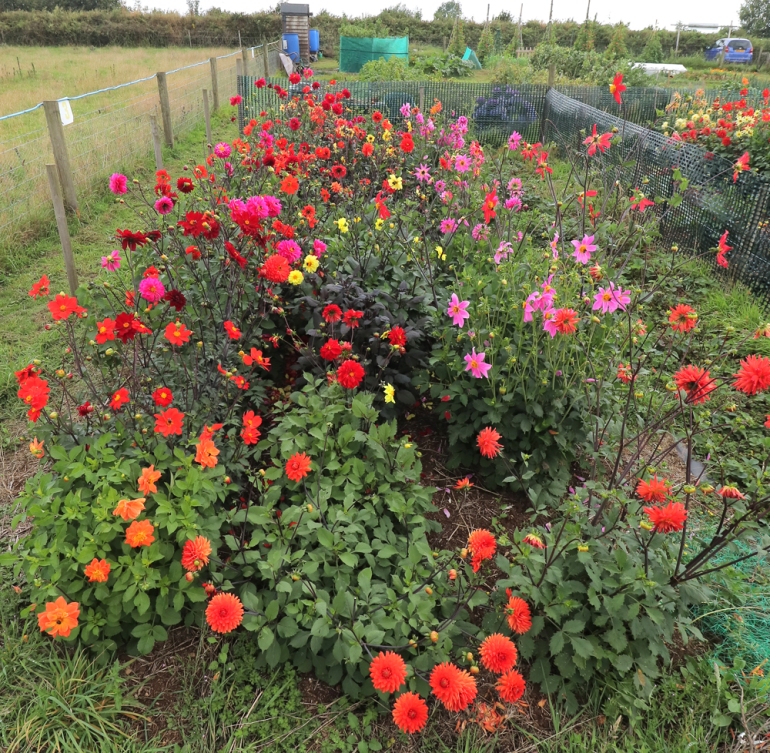
These are a representative set from row 1, mostly semi-double, mostly reds with some orange and pink.
In row 2 there are more singles, more yellows and some with very dark foliage.
The 2019 sowing of ‘Orange Cushion’, mostly single reds.
The left hand double row is Seedaholic’s cactus mix on the left, ‘Kalinka’ on the right foreground and ‘Orange Cushion’ at the top. The right hand double row, above the calabrese, is Seedaholic’s decoratives mix.
The seedlings of ‘Kalinka’ are mostly singles, mostly pale and somewhat streaky.
Seedaholic’s cactus mix is varied, free flowering but with some quite poor blooms. They were of quite uniform height and all had green leaves.
Seedaholic’s decorative mix is a wide ranging mix with singles and doubles in many colours. Uniform in height and all with green leaves.
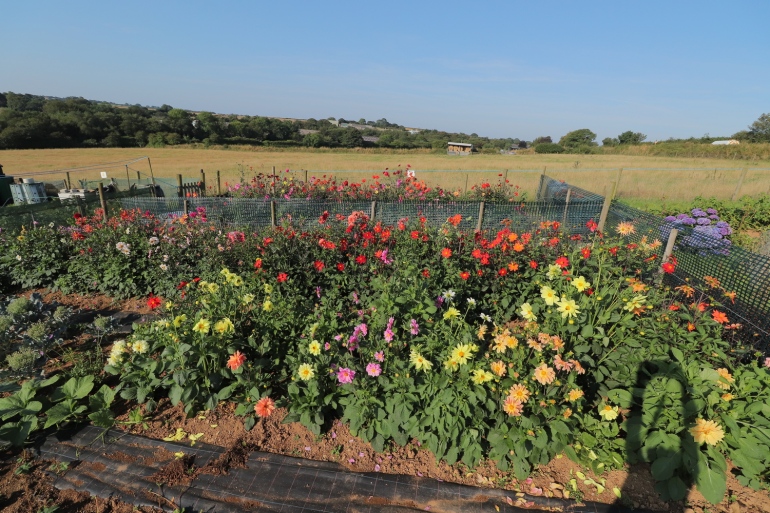
Most people don’t have the space to grow plants on this scale in their gardens, myself included. I have one and a half allotments, this is the half plot. The whole plot is for fruit and veg, this one is my playground.
Growing Dahlias from seed is very easy and very rewarding but the real pleasure of it comes from letting go of the tight control that characterises much of our gardening. We plan exactly what colour, height and habit of plant we want where and get cross when something doesn’t perform exactly as it said on the label.
With the dahlias there is so much anticipation as plant after plant starts to produce buds, then show some colour before finally opening out into total winner or also ran. In general, the best will be more than good enough to make up for the odd poor one.
Then there is the singular, indescribable pleasure of being surrounded by thousands of brightly coloured flowers, buzzing loudly with busy bees doing their business. I was delighted to see Dahlia ‘Bishop of Llandaff’ in Dave Goulson’s list of 16 favourite garden plants for pollinators in his book ‘The Garden Jungle’. All the singles are equally good and I have seen just as many bees on the semi doubles. Even the very double flowers eventually open out to a central disc which the bees set about.
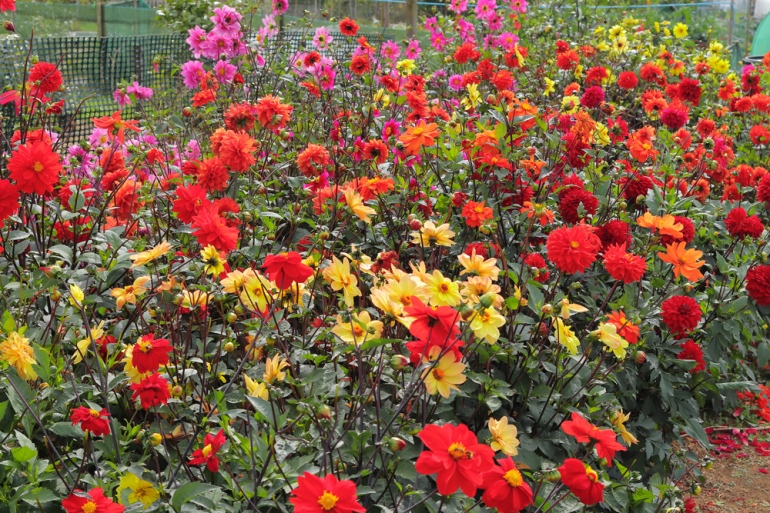
This was the three rows on my plot at their peak last year and below is a bed of seedlings at the National Dahlia Collection from 2017.
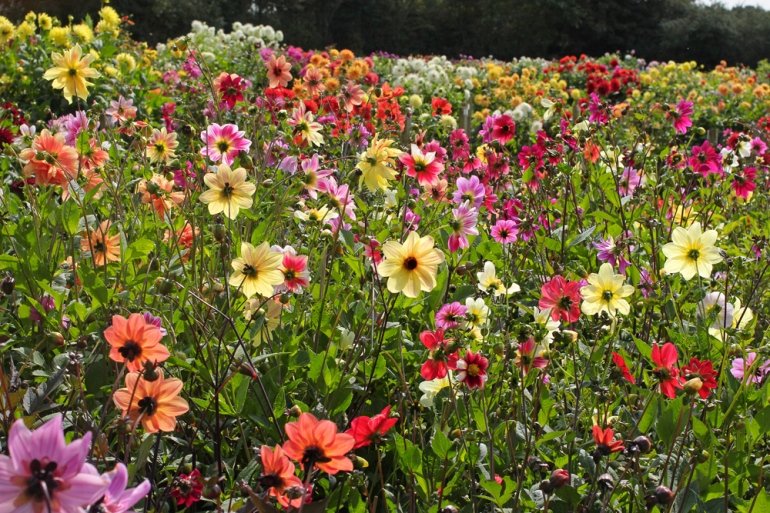
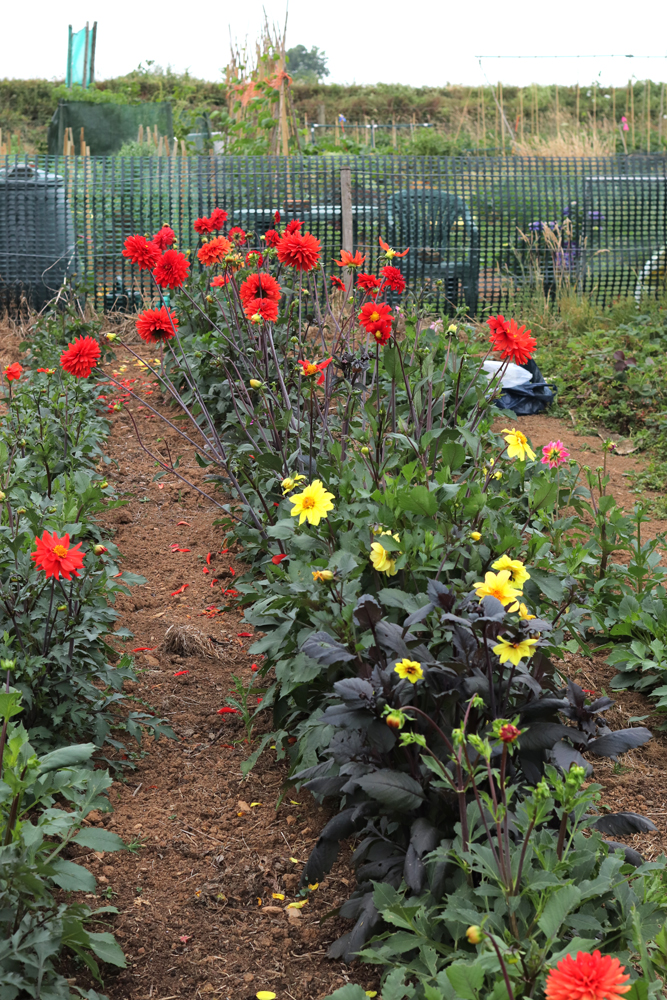
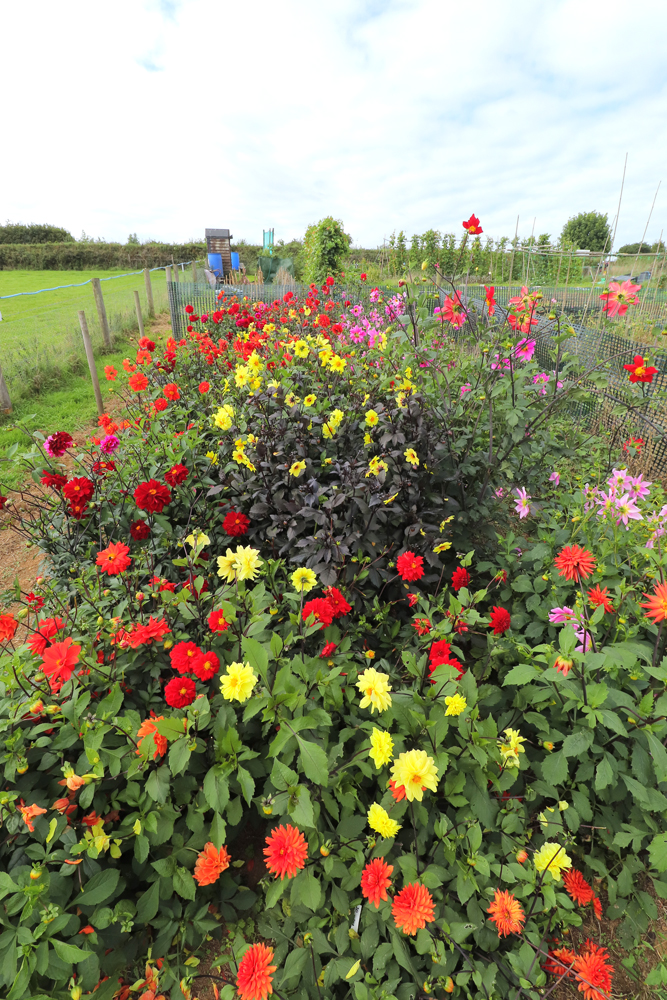

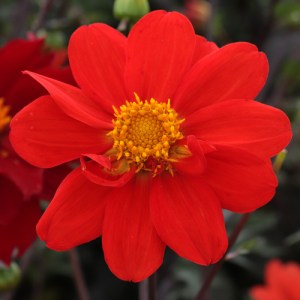



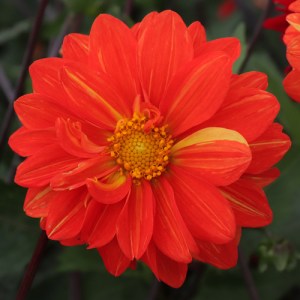
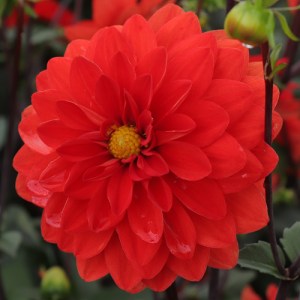



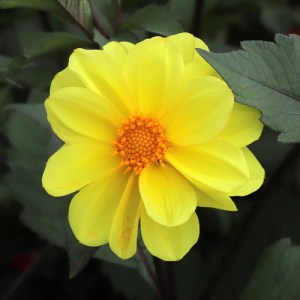
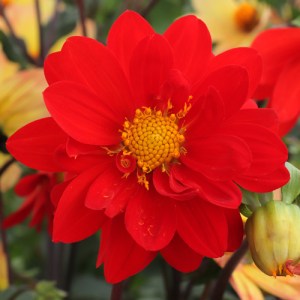












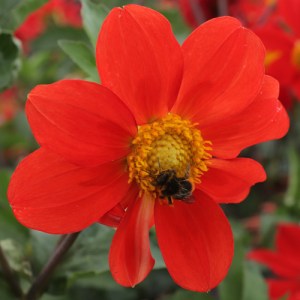
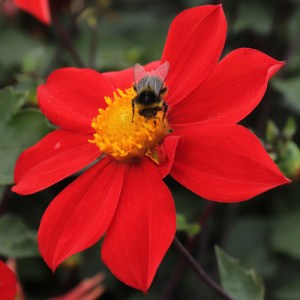


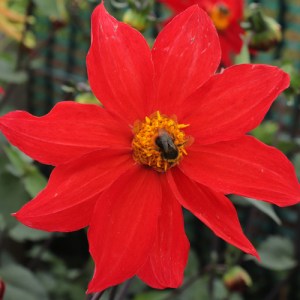


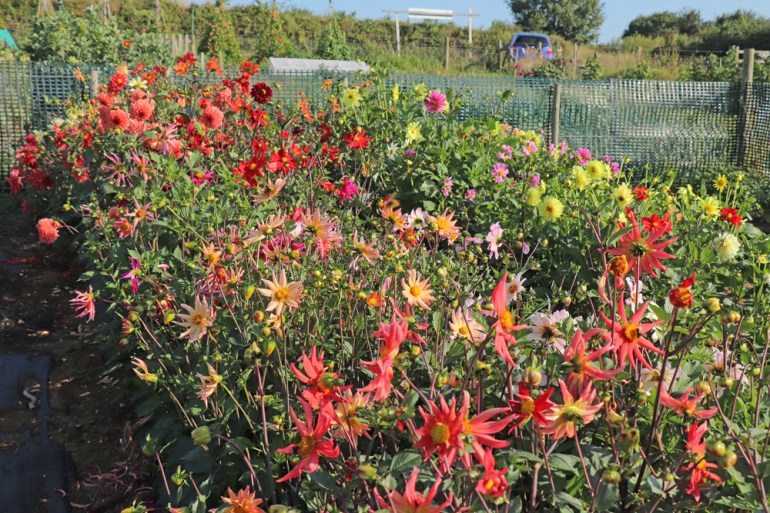


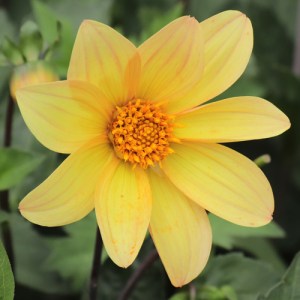
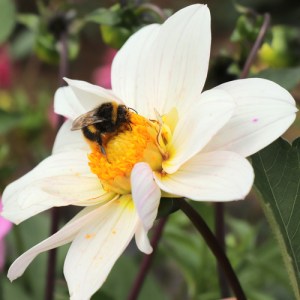









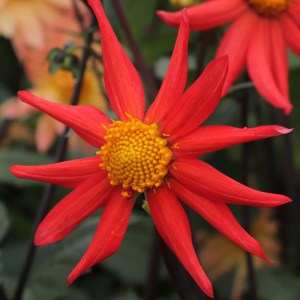

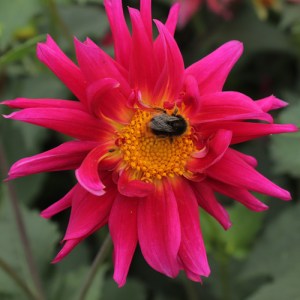



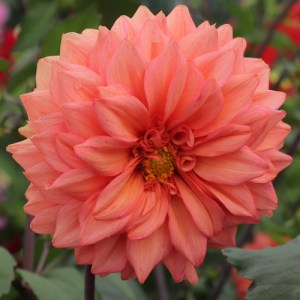
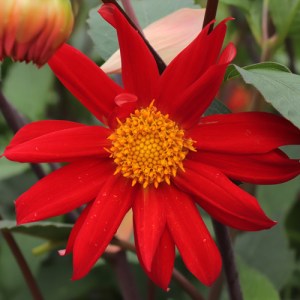


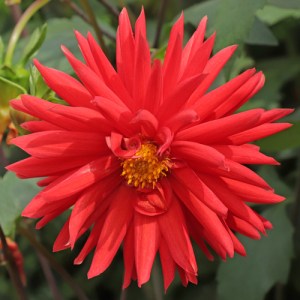
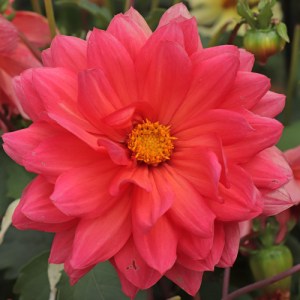


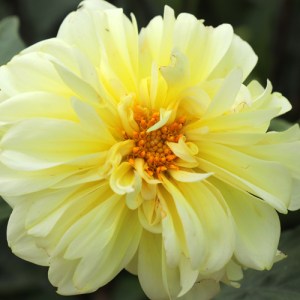










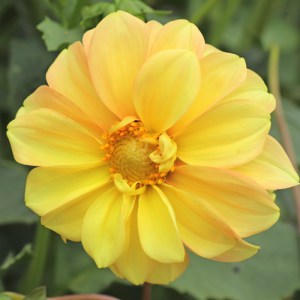

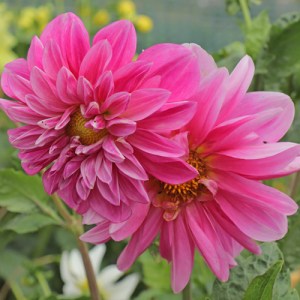
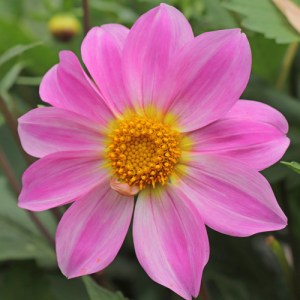

It seems that no matter how different they are from their parents, they are still pretty. Do you believe that they try to revert to a more genetically stable state with each generation?
LikeLike
Someone else had posted pictures of many seedling dahlias that looked almost like cosmos.
LikeLiked by 1 person
When people write about plants for bees they always say to plant single flowered varieties, but from what I’ve observed on my Dahlias, once double flowers have opened to show the disc, the bees visit them just as much. Even on very double flowers, the stigmas of the ray florets are still poking out to be pollinated. Perhaps only the disc florets produce pollen. Maybe there is much more pollen produced by single flowers than doubles, maybe because doubles can only be pollinated when fully open they set less seed, maybe doubles are more likely to be sterile, maybe the genes for doubleness are highly recessive. I don’t think plants try to reach a more stable state because I think that implies purpose, which I don’t believe they possess. But selection pressure of some sort favours the simpler flowers for sure. I think as far as dahlias are concerned I would rule out the idea that bees favour single flowers as being a component of that selection. Now I need to check the flower parts of single and double florets to see if ray florets have pollen producing stamens. Before you asked your question it hadn’t occurred to me but now I have a burning need to know!
LikeLiked by 1 person
Oh, I did not intend to sidetrack you.
The preference for single flowers is likely a generalization. I could see how it would apply to coreopsis and flowers that are ‘normally’ single, just because it is what those who pollinate them instinctually expect. Also, double flowers that are normally single are more likely to be genetically messed up. If double form is not to far from the norm for dahlias, it may not interfere much with their ability to produce pollen, or their familiarity to pollinators. (Although, it impressed me that insects on one continent recognize flowers from another.)
LikeLike
I remember being struck in New Zealand by how many white foxgloves there were, around 50% in many places. Much of their native flora has white flowers so maybe the whites were getting visited by insects and the pinks ignored. But bumblebees were also introduced there from Britain so that doesn’t really add up.
LikeLiked by 1 person
When I see naturalized foxglove up north, about half are white. I thought that was natural for them.
LikeLike
Not here it isn’t. White ones in the wild are rare, one in a thousand or less. I think they would be pollinated by bumblebees, maybe the species that does it is confined to Europe and they’re pollinated elsewhere by something that favours whites?
LikeLiked by 1 person
That makes sense of course. Australian flowers that use colors to attract Australian sunbirds change their colors here as they naturalize over a few generations, and rely on the native hummingbirds instead. Most insects, including many types of bees (such as common honeybees) are guided by infrared and ultraviolet patterns, which we can not see. I know with many flowers, the visible color is irrelevant to how bees see them. For example, the infrared and ultraviolet patterns of yellow and orange nasturtiums look the same to bees. However, that does not apply to all flowers; and perhaps the pink foxglove displays more of what the pollinating insects want. Or, they just happen to like pink.
LikeLiked by 1 person
You have some lovely flowers there, the Seedaholic’s decorative mix is particularly diverse in colour which is nice. I grew a few from the HPS seed (?bishops children?) Which have all (4 surviving) turned out single red with dark leaves. I forgot about the two I left in the polytunnel, which are now flowering in with my tomatoes! I was thinking about eating the tubers, but haven’t got round to trying them yet.
LikeLike
I think I’d have to be a little desperate to try Dahlias as food but I’d be interested to know how you found them if you did try. It gives me a backup excuse for growing flowers on my allotment, should one ever be needed. HPS seed of Bishops children would presumably be bishops grandchildren and it does seem to me that it matters a lot what is around to pollinate the flowers that seed is collected from.
LikeLiked by 1 person
I’m quite happy for them to be the same – I was just happy to have successfully grown them! I’ll do a post if I get round to eating any!
LikeLiked by 1 person
I think it is a charming way to grow a ‘surprise’, you have the ideal conditions mild enough for the tubers to overwinter in the soil. I love the bright splash of colour.
LikeLiked by 1 person
Snap, I’ve been doing the same thing here this year. It’s so exciting watching them all come into bloom. You have some beauties.
LikeLiked by 1 person
What a riot of color you have! I’m glad I don’t have the allotment next to you. I’d spend all my time being envious of your gardening abilities.
LikeLiked by 1 person